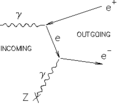Pair production facts for kids
Pair production is a cool event in physics where pure energy turns into matter! It happens when a very energetic light particle, called a photon, gets close to the center of an atom, which is called the nucleus. Instead of just bouncing off or interacting with the atom's outer electrons, this super-strong photon gives all its energy to the nucleus.
When this happens, the photon's energy suddenly creates two new particles: a regular electron (which has a negative charge) and a positron (which is like an electron but has a positive charge). These two new particles then zoom off in opposite directions. It's like magic, but it's real science!
How Pair Production Works
When a high-energy photon passes very close to an atom's nucleus, the nucleus acts like a tiny, heavy target. The photon, which is a packet of energy, transforms into two particles:
- An electron: This is a tiny particle with a negative electric charge.
- A positron: This is the "antiparticle" of an electron. It's exactly like an electron but has a positive electric charge.
This process follows Albert Einstein's famous equation, E=mc², which shows that energy (E) and mass (m) can be converted into each other. In pair production, the photon's energy is converted into the mass of the electron and positron, plus their kinetic energy (the energy of their movement).
The positron doesn't last long. It quickly finds a free electron nearby and they combine in a flash of energy, turning back into photons. This is called annihilation.
When Does Pair Production Happen?
Pair production only happens when the incoming photon has a lot of energy. This energy must be at least enough to create the mass of both an electron and a positron. This minimum energy is about 1.022 MeV (Mega-electronvolts). A Mega-electronvolt is a huge amount of energy for a single particle! For comparison, the light you see every day has much, much less energy.
The chance of pair production happening also depends on the type of material the photon hits. Materials with a higher atomic number (meaning their atoms have more protons in their nucleus) are more likely to cause pair production.
You might hear about pair production in some special situations, like in radiation therapy. This is a medical treatment that uses high-energy beams to treat certain illnesses. Sometimes, the high-energy photons used in these treatments can cause pair production.
Images for kids
-
This is a Feynman diagram, a special drawing physicists use to show how particles interact. It illustrates pair production.
See also
 In Spanish: Creación de pares para niños
In Spanish: Creación de pares para niños


